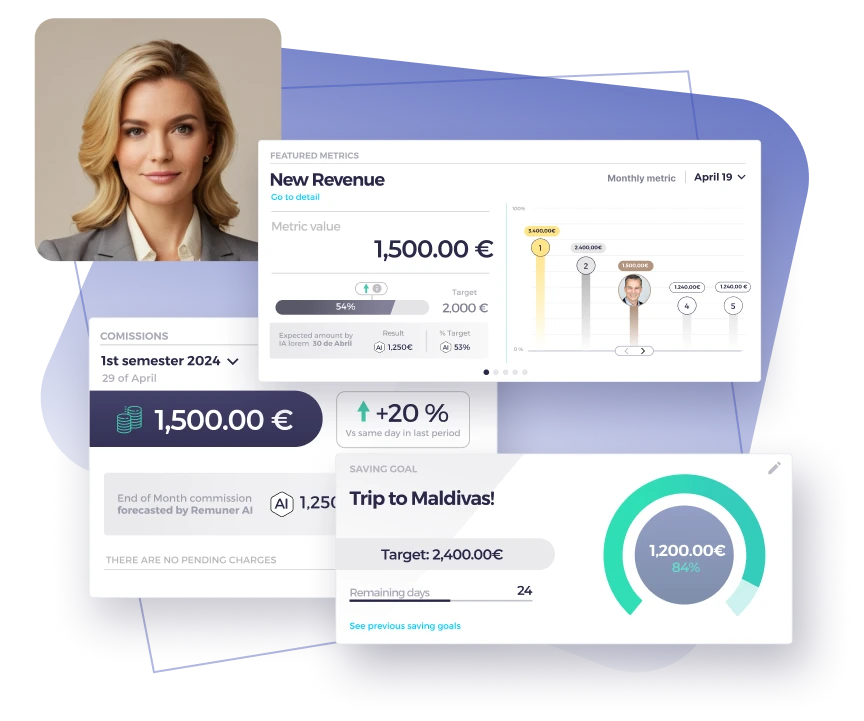Table of contents
A strong compensation model is more than just a paycheck. It’s a strategic tool that aligns employee motivation with business goals. It can attract and retain top talent, increase sales performance, and drive profitability. But without a clear compensation structure, even the best teams can underperform.
In this guide, you’ll learn how to build a performance-based compensation model that fits your business, motivates employees, and scales with growth.
What is a compensation model?
A compensation model defines how employees receive pay and benefits. It includes base salary, hourly wages, variable pay, sales incentives, indirect compensation (like health insurance), and bonuses.
A good compensation model should:
- Align with business goals and performance metrics
- Reward top performers without overspending
- Stay competitive in the talent market
- Be easy to understand and manage
👉 Companies using a sales compensation software like Remuner can automate these models, ensuring accuracy, transparency, and alignment across teams.
Why your compensation model matters
Your compensation model shapes:
- How you attract and retain top talent
- How motivated your team members feel
- How well your business performs in the long term
Research from Gallup shows that engaged employees not only perform better but also drive growth across the organization. It directly affects your bottom line. A poorly structured model creates disengagement, while a strategic model increases productivity and reduces turnover.
Key components of a compensation model
To build an effective compensation model, you must balance multiple components:
| Component | Description |
| Base pay | Fixed salary or hourly wages paid regardless of performance |
| Variable pay | Performance-based bonuses, commissions, or incentives |
| Total compensation | All pay + benefits like health insurance, stock options, and perks |
| OTE (On-target earnings) | Expected total earnings if the employee hits their quota |
| Quota | The performance target (often sales-based) that triggers variable pay |
| Compensation package | The complete offer made to an employee, including indirect compensation |
Each element influences your compensation strategy and impacts how your employees perform.
Popular compensation models (with examples)
1. Straight salary model
Employees receive a fixed base salary, no matter their performance.
Best for: Customer service, support teams, or junior sales reps.
✅ Easy to manage
❌ May not motivate high performance
2. Commission-only model
Pay depends entirely on performance — no base salary.
Best for: High-risk, high-reward sales environments.
✅ High earning potential
❌ Unstable income may reduce retention
3. Base salary + commission (most common)
Combines fixed base pay with performance-based variable pay.
Best for: Most B2B sales teams.
✅ Balanced, scalable, and performance-driven
❌ Can become expensive without clear tracking
📌 With Remuner, you can track commissions in real time and customize compensation rules by role, region, or deal size.
4. Tiered commission model
The more someone sells, the higher the commission rate.
Example:
- 5% commission up to $100K
- 7% commission between $100K–$250K
- 10% for anything above $250K
Best for: Scaling businesses and overperforming teams
✅ Motivates employees to exceed goals
❌ Can be hard to calculate manually
➡️ Learn more: Remuner’s commission structure builder
5. Profit-based compensation
Employees receive bonuses based on company or team profits.
Best for: Executive roles or collaborative teams.
✅ Encourages long-term thinking
❌ Hard to link individual performance
6. Role-based pay structures
Each role has a different compensation strategy tailored to their impact.
Example:
- Sales: OTE + tiered commissions
- Engineering: Base salary + stock options
- Customer success: Base + retention bonuses
📌 Remuner makes it easy to assign tailored plans by role or department using automated compensation workflows.
How to choose the right compensation model
Follow these steps to design the right model:
1. Align with company goals
Do you want to drive short-term sales, retain talent, or increase profitability?
2. Know your team
What motivates your team members — base pay security, career growth, or high commission?
3. Define measurable KPIs
Use performance metrics like closed deals, customer retention, or upsells.
4. Balance fixed and variable pay
Variable pay drives results. Fixed pay provides security. Mix both smartly.
5. Consider long-term scalability
Your model should grow with your business — not break under pressure.
Compensation model challenges
Even a great model can fail if not implemented well. Here are common issues:
- Manual calculation errors
- Unclear quotas
- Disconnection between HR, Sales, and Finance
- Lack of transparency
📌 Remuner solves these problems by automating commission tracking, integrating with your CRM, and providing dashboards that align teams around real-time sales performance.
How compensation models impact performance
When your compensation model works, it boosts:
- Motivated employees who know exactly what they need to do
- Faster deal cycles and better win rates
- Lower turnover due to fair, performance-based pay
- Improved bottom line through higher ROI on payroll
💡 Tip: Regularly review your compensation strategy as your business and teams evolve.
FAQs about compensation models
What is the difference between compensation and total compensation?
Compensation usually refers to base pay and bonuses. Total compensation includes base pay, bonuses, health insurance, perks, stock options, and any indirect compensation.
What is a compensation model example?
A common example: A sales rep receives a $50,000 base salary and a 10% commission on sales above $100,000.
How does OTE fit into compensation models?
OTE (On-Target Earnings) is the total amount an employee earns if they hit their quota. It includes base pay + commissions.
What is a quota in a compensation model?
A quota is the performance goal, often sales-based, that an employee must reach to unlock their variable pay.
What are the best compensation models for startups?
Startups often use base salary + commission or tiered commissions to motivate early hires and scale performance.
How can I simplify managing compensation plans?
Use a sales compensation software like Remuner to automate payouts, align goals across teams, and reduce manual errors.





